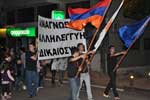Η Στήλη του Σασσουνιαν

Constitutional Court Limits Protocols’ Damage to Armenian National Interests
After months of bickering among Armenians the world over about the Armenia-Turkey Protocols, the Constitutional Court of Armenia on January 12 pronounced its judgment on whether the obligations stipulated by the Protocols comply with the constitution.
The Court’s task would have been relatively easier, if it were to simply deal with the legal aspects of the Protocols which would have required a yes or no decision followed by a brief explanation. Yet the fact that the Court’s verdict was eight pages long and contained scores of clarifications, interpretations, explanations, and restrictions, indicated that the Justices of the Court had to walk a tightrope between safeguarding Armenia’s relations with major foreign powers and minimizing the potential damage the Protocols could cause to the Armenian national interest.
Since the Court was apparently reluctant to reject outright these badly-negotiated and poorly-worded Protocols, it did the next best thing: accept the Protocols after placing a large number of restrictions on their legal interpretation and implementation. Thus, the Court’s decision partially vindicates all those who have been expressing their serious reservations regarding the negative aspects of the Protocols.
Here are some of the main interpretations and limitations that the Court placed on the Protocols:
- The Court made all clauses of the Protocols conditional on the implementation of two main obligations: "establish diplomatic relations" and "open the common border." The Justices thus made these two actions a necessary prerequisite for the fulfillment of all other obligations to be undertaken by Armenia and Turkey.
- The Court narrowly interpreted the "open the common border" clause of the Protocols, indicating that Armenia was simply making a commitment "to resolve legal-organizational and institutional issues connected to safeguarding the normal operation of border checkpoints." Significantly, the Court used the term "checkpoint" rather than "border," thereby indirectly refusing to accord legal recognition to Armenia’s present boundary with Turkey. Since it was Turkey that closed the border, it alone is responsible for re-opening it. Armenia’s obligation, on the other hand, is limited to simply making the necessary administrative arrangements to permit passage through a checkpoint.
- The Court ruled that only those international treaties that have been ratified under the constitution of the present Republic of Armenia could be considered legally valid. The clear implication is that border issues regulated by treaties pre-dating the Republic’s existence cannot be considered valid. This interpretation contradicts frequent Turkish declarations that the Protocols reconfirm Armenian territorial concessions to Turkey, specifically referencing the 1921 Treaty of Kars. Indeed, the Court pointedly downplayed the overall significance of these Protocols by mandating that all future treaties that establish and further develop relations between Armenia and Turkey require its specific approval.
- The Court countered the text of the Protocols which included specific language about multilateral obligations, by asserting that the documents in question were "exclusively of a bilateral interstate nature." The Justices thus precluded Turkey from interfering in the Karabagh (Artsakh) negotiations and making the improvement of Armenia-Turkey relations conditional on the resolution of that conflict.
- The Court took issue with Turkish statements that the aim of the historical commission envisaged by the Protocols is to review the facts of the Armenian Genocide. The Justices clearly stated that the provisions of the Protocols could not contradict the preamble of the constitution which includes a reference to Armenia’s Declaration of Independence. Article 11 of the Declaration stated: "The Republic of Armenia stands in support of the task of achieving international recognition of the 1915 Genocide in Ottoman Turkey and Western Armenia."
The key question now is what happens next?
At a minimum, the Constitutional Court has limited some of the damaging aspects of the Protocols by ruling that any laws emanating from the Protocols, after parliamentary ratification, cannot violate the constitution of the Republic of Armenia.
Of course, it would be far more preferable if the Parliament were to reject these Protocols outright. Regrettably, this is unlikely, as the Parliament is dominated by pro-government deputies. If rejection is not a possibility, the President of Armenia and the Parliament should at least consider specific reservations or changes to these Protocols in line with the Constitutional Court’s decision.
Failing that, Armenians who oppose the Protocols must pin their last hope on the Turkish Parliament’s insistence that it would not ratify the Protocols until Armenia withdraws from Artsakh. Should the Turkish Parliament not ratify the Protocols, it would be highly ironic if Armenians had to rely on Turkish actions in order to protect their national interest!
By Harut Sassounian
Publisher, The California Courier




















